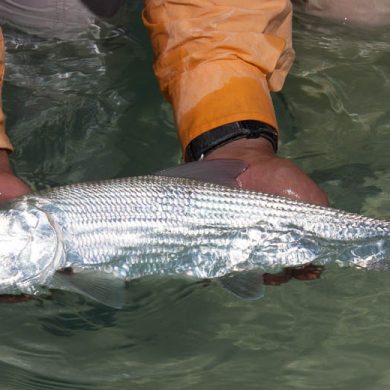NEW FIGURES even before the season’s end yesterday show that of 200 salmon released and tagged after capture on the River Gaula below Gaulfossen this season, 30 per cent have been re-caught by anglers. The figure is even more surprising when compared with equivalent data on neighbouring river that flow into the huge Trondheim-fjord basin.
On the Orkla the figure of re-caught tagged fish is eight per cent. And on the 22-miles of angling effort on the Verdal River, including its tributary Inna, the figure is just eight per cent.
The immediate implication of the above figures are to reveal a greater angling pressure on the Gaula than on many of the other 30 rivers that flow into the basin.
Most of the Gaula tagging effort occurred on the Gaulfoss beat of the river, in the very productive earlier part of the season before fish started to run this natural obstacle to salmon passing upstream on July 4. This delayed upstream movement of fish meant a very good catch of 25 tons of fish were taken from the lower river this year, with a further 10 tons of fish taken from July 4 to very near the season’s end. With more figures set to come in this shows a total Gaula catch of 35 tons, which compares well with an average year of 28-35 tons.
Simon Kitcher, an experienced English guide on the Gaula who first fished the river 30 years ago and guided throughout the early part of the season at Gaulfoss, said: ‘We caught 270 salmon at Gaulfoss and released 170. There are encouraging reports of a strong C+R showing on the river and this effort is especially strong on the Gaulfoss beat and the beats around Storen where the Norwegian Flyfishers Club is centred.”
But in a reference to heavy fishing in the very unusal high, cold water fishing conditions on the river in 2012 that trapped fish in the lower river and led to a situation that occurs only about every 10 years or so, Simon added: ‘Some of the fish we caught had wormers’ hooks, and spoons and spinners still in their mouths.’
All rivers flowing into the Trondheim fjord have benefitted greatly from the delayed bag-net fishing start and the Trondheim fjord buyout of bag-net fishing in the huge fjord and nearby coastal areas. More plans to buy out nets in the fjord are in hand.
Elsewhere in Norway, new research from the famous River Alta in the north of the country has revealed fascinating data coming from salmon that were radio tagged after their capture and release. It seems these fish do not then progress further up the river to spawn, but remain in or below the pool where they were captured. This has big implications and suggests a greater impact to being caught and released than previously thought – although studies show the survival rates of C+R fish are very high indeed, up in the 90s of percentages for the most part where fish have been released properly.

